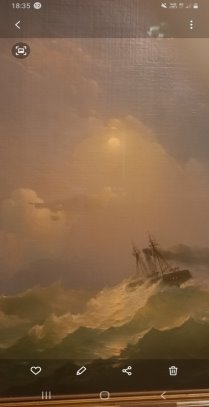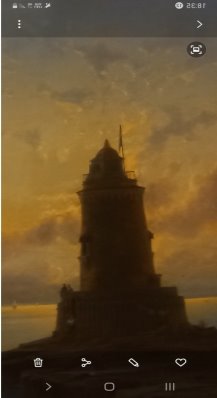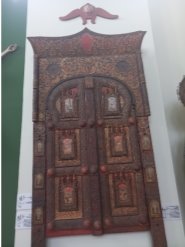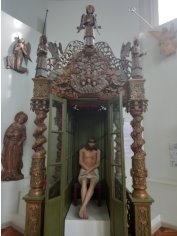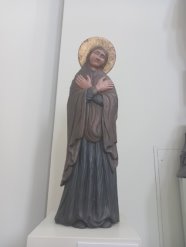Методическая разработка создана в форме образовательного путешествия, такой формат является особой технологией освоения мира, позволяющей организовать самостоятельную исследовательскую деятельность учащихся, где учитель выступает в роли тьютора учащихся в их самообразовании [1].
В качестве места выбрана Пермская государственная художественная галерея, потому что она является важной частью культурного наследия Пермского края.
Образовательное путешествие проводится на английском языке, по окончании путешествия учащиеся будут не только знать, где находится галерея, историю ее появления, своими глазами увидят картины и скульптуры русских и зарубежных художников, определятся с собственными художественным предпочтениями, познакомятся или в очередной раз увидят уникальную деревянную скульптуру Пермского края, но и научатся говорить об этом на английском языке. Это позволит им быть способными рассказывать об одной из достопримечательностей родного города иностранным туристам, когда такая возможность появится.
Работа строится следующим образом: учащиеся обсуждают достопримечательности Перми, которые были бы интересны иностранным туристам. Далее учащимся предлагается возможность посетить Пермскую государственную художественную галерею с учителем, они делятся на группы по 3–4 человека, им выдаются маршрутные листы, на которых прописаны 5 локаций, которые учащиеся посещают в галерее и на каждой локации отвечают на вопросы, пользуясь пространством и экспонатами галереи. Ребятам также выдаются бланки ответов, куда они вписывают ответы на вопросы. В конце путешествия ребятам предлагается рассказать иностранным туристам, почему Пермская галерея стоит того, чтобы ее посетить.
Локация 1 — площадь перед зданием Пермской государственной художественной галереи и памятники, находящиеся на площади;
Локация 2 – общее знакомство с галереей;
Локация 3 — знакомство с русским искусством XV — XX века;
Локация 4 — знакомство с искусством Западной Европы XV — XIX века;
Локация 5 — знакомство с Пермской деревянной скульптурой XVII — XIX века.
Методическая разработка может быть полезна учителям 7–11 классов.
Imagine that you are approached by a foreign tourist and asked to give advice on what sight is worth visiting in Perm. What would it be? Why? Are you aware of its background? What facts about the sight can you share? If you feel puzzled and are put at a loss, join our educational journey to one of the most noted Perm sights — the Perm State Art Gallery.
Split in groups of 3–4, take the map and do all the tasks presented there (fill in the answers on the answer sheet). At the end of the journey be ready to answer the question we started with. Grab your classmates and the teacher and go to the Gallery.
The Map
The 1 st location “Let’s get started”
You are on the square in front of the Gallery. Get a good look at it and admire the view on the Kama River. Now answer some questions, the objects on the square (the monuments, information boards) will help you get the answers.
Question 1. What is the address of the Gallery?
Question 2. What is the name of the square it stands on?
Question 3. What are the two monuments you can see on the square?
Question 4. What do we call the building occupied by the famous Perm State Gallery?
The 2 nd location “Get inside”
Go up the stairs, open the magnificent doors and get inside. The entrance is free of charge for you, so go through metal bars right to the cloak room where you can leave your clothes. Now ascend the stairs, on your right and left you will see boards with some information about the Gallery, look through them and proceed farther. Be ready to answer the following questions:
Question 5. When was the Bell Tower built?
Question 6. You can see Russian art (the 15 th — 20 th centuries) on the:
a) first floor
b) second floor
c) third floor
Question 7. You can see exhibits of Perm Wooden Sculpture (the 17 th — 19 th centuries) on the:
a) first floor
b) second floor
c) third floor
Question 8. You can see art of Western Europe (the 15 th — 20 th centuries) on the:
a) first floor
b) second floor
c) third floor
The 3 rd location “Russian Art”
Go along the halls of the first floor and enjoy the works of famous Russian painters. Answer the questions below.
Question 9. Give the name of at least one painting which depicts ancient myths. Who painted it?
|
Question 10. What’s the painting below called? Who painted it?
|
Question 11. Look at part of the painting below? What is its name? Who painted it?
|
|
Question 12. Who is the painter of the picture below?
| |
Question 13. How many paintings by Ivan Ivazovsky are there on display?
The 4 th location “Western European Art”
Now move on to the second floor and get acquainted with the art of Western Europe. There is just one question to answer:
Question 14. Give example of a still life/ (name, painter).
The 5 th location “Perm Wooden Sculpture”
Go up the stairs to the third floor and see unique wooden gods with your own eyes. Answer the following questions.
Question 15. How many sculptures of carved wooden gods does the gallery contain?
Question 16. Who were they created by and when?
|
Question 17. What is the name of the exhibit below?
|
Question 18. What do we call the exhibit below?
|
|
Question 19. What is the name of the exhibit below?
| |
Question 20.
What painting or sculpture impressed you and your groupmates most? Why?
Let’s get back to the beginning of the journey. What place of interest is worth visiting in Perm? Why? What is special about it? (use your answer sheets) Did you enjoy the journey?
Answer sheet
|
Team 1 | |
|
Participants:
| |
|
Answers: |
The 1 st location “Let’s get started” |
|
1. | |
|
2. | |
|
3. | |
|
4. | |
|
5. |
The 2 nd location “Get inside” |
|
6. | |
|
7. | |
|
8. | |
|
9. |
The 3 rd location “Russian Art” |
|
10. | |
|
11. | |
|
12. | |
|
13. | |
|
14. |
The 4 th location “Western European Art” |
|
15. |
The 5 th location “Perm Wooden Sculpture” |
|
16. | |
|
17. | |
|
18. | |
|
19. | |
|
20 | |
Литература:
- https://infourok.ru/obrazovatelnoe-puteshestvie-kak-metod-obucheniya-v-urochnoy-i-vneurochnoy-deyatelnosti-1408858.html
